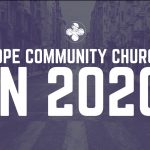The end of Luke’s gospel tells the story of the first ever Easter Sunday. Before the springtime pastels, traditions, and egg-wars (not complaining, I’m very good at these). This is a big day. And where do we find the main character?
The last time we see him, in the concluding verses of Luke 23, Jesus has taken his last breath. The once animated, living human being has become a motionless corpse. No longer is our main character even referred to in the third person, instead he has become a lifeless object:
52 Going to Pilate, [Joseph] asked for Jesus’ body. 53 Then he took it down, wrapped it in linen cloth and placed it in a tomb cut in the rock… (Luke 23:52-53, emphasis added)
Two days of darkness full of mourning, confusion, silence. On the third day, a group of women arrive at the tomb early in the morning…but the main character is missing. No Jesus. Where has he gone? The author leaves us hanging.
Do You Live Under a Rock?
The screen suddenly shifts bringing two men into focus as they are walking down a long road discussing all that has just taken place that weekend. They recount how the guy who they thought was going to finally bring lasting change around here, ended up dying – but not only that he died, that he died the brutal death of a lowly criminal. What was the point of the last three years of our lives following this guy?
A third character walks into the scene. The first two fail to recognize him. He asks what they are discussing as they are walking along.
The two men respond… “What are we discussing? What else is there to discuss?? Surely, you are the only one who doesn’t know all the things that have taken place around here in the last few days! Have you not heard about the courage, kindness, and strength of the man Jesus? How he was betrayed by one of our own, brought through an unjust trial, beaten before being strung up on a cross. What’s more is we just heard news that some women visited his tomb this morning but found the stone rolled back with no body inside.
The women were told he is alive.
Jesus Prioritizes Your Understanding
Upon hearing the facts, the third character asks if either of them has a copy of the Old Testament on them. Opening the Scriptures, he begins to teach:
And beginning with Moses and all the Prophets, he explained to them what was said in all the Scriptures concerning himself.
A passage like Isaiah 53 would have been an easy place to camp out and explain how everything that had just taken place was always God’s Plan A. Instead, Jesus begins his lesson on page one of the Bible and proceeds to show how ALL the Scriptures are in fact about him and his gospel. Each narrative, promise, poem, law, and proposition all work together to point out, contrast, whisper, shout, or reveal the good news of Jesus solving the human problem of our coldness toward and rebellion against God. Picture him reading the first few sentences of Genesis 1 to these two men and explaining how even in the beginning, when God spoke light out of darkness, he was laying the blueprint for Jesus, the light of all mankind, to come shine in our darkness and bring us the knowledge of God’s glory displayed in the face of Christ.
Or picture them turning to Exodus 19 where the Law was first given at the foot of a stormy mountain charged with the words “if you do this then you will live.” They observe the loud darkness and the gloom paired with the sounds of the people in fear begging that no further word be spoken to them because they already stood condemned. Imagine Jesus describing how that scene contrasts the better word that his gospel is now speaking at an eternal mountain where songs replace storms, and true rest replaces works. Where there was once a command to “do this and live” there is now a better word: “it is finished.” In the new covenant, the only form of “do this” is not a stipulation, or a standard to be met, but an invitation to grow in and remember the one man who died so that all who would look to him might live…forever.
Jesus comes to these two when they’re not even looking for him to interrupt their lives with himself and his gospel which clarifies and makes sense of the facts they already possess. On DAY ONE back from the dead, Jesus’ first priority is to teach two random, common individuals how to understand both the Bible and its impact on their circumstances.
Good News Causes Heartburn
The two men walking on the road had all the facts but still failed to understand. They had been well practiced in a method of reading the Scriptures that caused them to be blind to what was happening around them and downcast in the presence of the most joyful man on earth. Jesus disrupts their sadness and their confusion with glad explanation and clarity about who he is and what he has done on their behalf.
When their eyes are later opened and they recognize Jesus, one says to the other “were not our hearts burning within us while he talked with us on the road and opened the Scriptures to us?”
This is the result of the gospel. It causes lives to change and hearts to burn. Jesus takes our sin upon himself, dies in our place and overcomes the grave. God never grows tired of revealing the depth, shape, power, intrigue, and mystery of this news. The gospel is a stack of hot embers. Luke 24 is an invitation for us to throw portions of Scripture on top of these embers to experience firsthand the warmth of the gospel’s ability to light up any passage like a dead Christmas tree catching fire.
The next time you pick up the Bible, imagine yourself in light of Luke 24, walking on the road in the presence of Jesus. Consider him coming toward you to help you recognize him in all of the Scriptures, to teach you all the things concerning himself, and to replace your downcast heart with the hope, clarity, and contentment that only he can bring.




